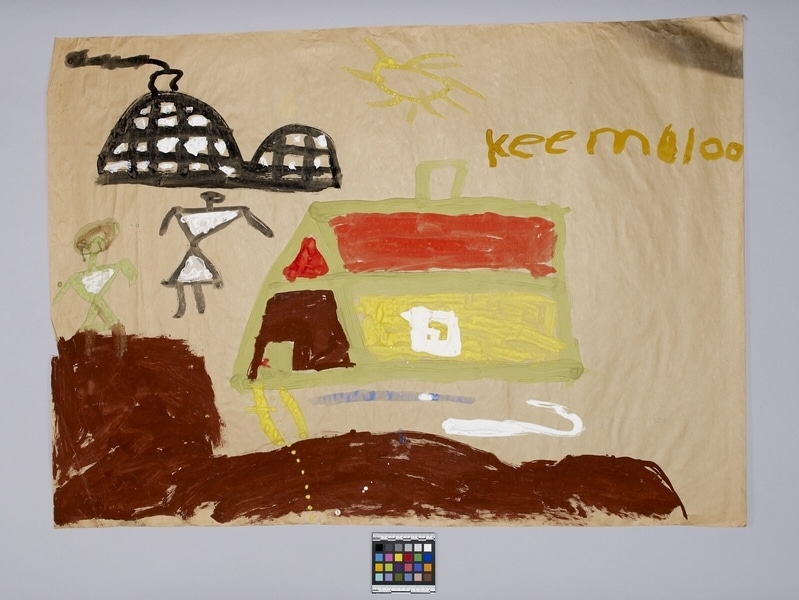Painting Item Number: Na1583 from the MOA: University of British Columbia

Description
Painting of a two-part igloo that has a chimney, a house, and two people. The igoo is made of white blocks outlined by black and is on the upper left side. Below the igloo, there are two people in white with the left person of which outlined by green while the right one of which is outlined by black. Next, to the right side, there is ahouse with an orange-red roof, a brown front with a lime green door, and a yellow side with a white window. The house is outlined by olive green and has a chimney. There is a yellow sun to the right of the igloo and above the house. From the lower left portion along the rest of the lower edge, there is a brown patch. In orange, above the house, has been painted 'Keem[?]loo' with the same writing in pencil below. The painting is on horizontally rectangular brown paper (now hinged onto matboard backing and framed).
History Of Use
During World War II, several air bases were constructed in the Canadian Arctic. One of these was an American airbase at Frobisher Bay (now Iqaluit), around which a “shantytown” developed. The federal government founded Apex Hill in 1955 in an attempt to draw Inuit away from the base, building houses, a nursing station, a rehabilitation centre and a school there. In this painting we see a child’s impression of the place. Some people were living in snow houses, while others had moved into “southern-style” buildings called 370S or 521S, depending on their square footage. The artist has caught an important moment of transition in the North.
Item History
- Made by Keemeloo (Maker) in Apex Hill, Nunavut, Canada between 1958 and 1959
- Collected during 1958
- Owned by Gordon Yearsley before November 13, 1980
- Received from Gordon Yearsley (Donor) on November 13, 1980
What
- Name
- Painting
- Identification Number
- Na1583
- Type of Item
- painting
- Overall
- height 66.4 cm, width 91.5 cm
- Frame
- height 79.5 cm, width 104.5 cm
Who
- Culture
- Inuit
- Creator
- Keemeloo (Maker)
- Previous Owner
- Gordon Yearsley
- Received from
- Gordon Yearsley (Donor)
Where
- Holding Institution
- MOA: University of British Columbia
- Made in
- Apex Hill, Nunavut, Canada
When
- Creation Date
- between 1958 and 1959
- Collection Date
- during 1958
- Ownership Date
- before November 13, 1980
- Acquisition Date
- on November 13, 1980
Other
- Item Classes
- works on paper; paintings
- Condition
- good
- Accession Number
- 0669/0011